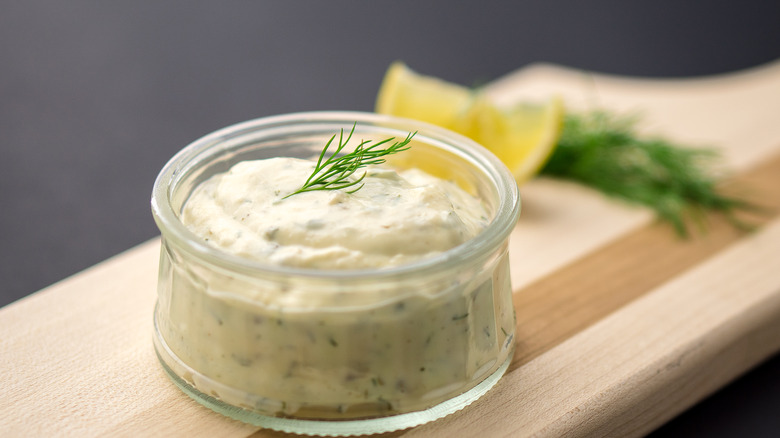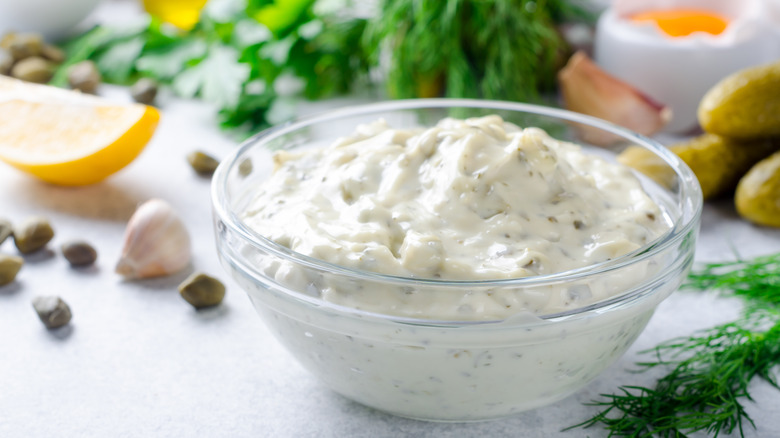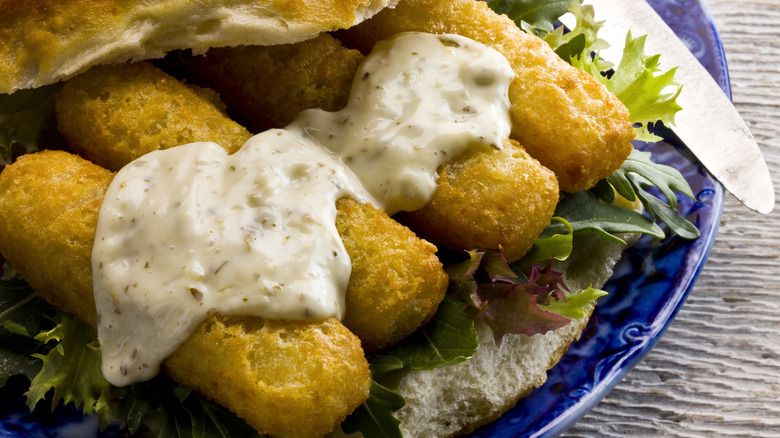How To Make Tartar Sauce With Just 3 Ingredients
There's nothing quite like tartar sauce when you want to elevate the flavor of any crispy, flaky fried seafood. From a formidable fried catfish to the light, breaded cod in a beer-battered fish and chips, tartar sauce and fried seafood go together like pork satay and peanut dipping sauce. Whether you're beer battering a fish filet, frying it delicately, and hand-cutting some fries to go with it yourself or simply ordering your favorite delivery, creating your own tartar sauce is a fast and delicious way to level up your meal.
No matter if you're in a time crunch, haven't been able to go to the store, or simply enjoy the thrill of creating your own sauce, tartar sauce is not as daunting as it may seem. In fact, all that's really needed to create an excellent dip is mayonnaise, pickle relish, and lemon. Other items can be added for extra flourish, but as long as you have these three ingredients somewhere in the pantry, you'll be in excellent shape to create this sauce.
How to build your own tartar sauce
The simplest recipe for tartar sauce will call for just mayo, relish, and lemon. Start with one cup of mayo and add two tablespoons of pickle relish — dill or sweet will work, but savory relish gives you that classic tartar sauce flavor. Then, just squeeze about 1½ teaspoons of lemon juice into your bowl, and mix. In just a couple of minutes, you can create this excellent, three-ingredient sauce.
However, feel free to get creative with whatever you have on hand. Adding a touch of salt and pepper will bring a new dimension to the sauce. Like an easy tzatziki recipe, sprinkling in some dill can also dramatically enhance the herbal freshness of your tartar sauce. If you don't have any relish, you can chop some pickles or capers instead. Want to bring some tang to your sauce? A dash of Worcestershire sauce or a dollop of mustard can do the trick. You can even swap out the mayo for aioli if you prefer a more garlicky flavor. Any number of ingredients can be added to your tartar sauce, but the underlying flavor-texture trinity will always be: creamy, herbal, and tangy.
The many adaptations of tartar sauce
What we call tartar sauce today was popularized as a sauce that accompanied steak tartare — but which came first, the meat or the sauce, is up for debate. French cooks in the 19th century attributed the consumption of raw beef to the Tatar people of central Asia. By the turn of the 20th century, this raw, minced beef dish with egg yolk, capers, and onions was being served with a tangy, white sauce on both sides of the Atlantic. Sometimes also called "steak à l'Américaine," steak tartare is largely responsible for the spread of tartar sauce as we know it today.
In addition to pairing well with virtually any fried and battered seafood, tartar sauce can also be used with chicken tenders, burgers, sandwiches — even roasted, baked, or fried potatoes — or deviled eggs. Think of using tartar sauce as a spread for fried chicken sandwiches or as a condiment base for potato salad or coleslaw. You can even use your three-ingredient version of the sauce as a quick and easy dressing for a salad. The applications are truly endless.



